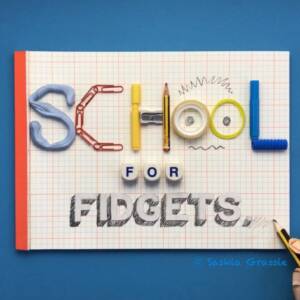
A short film about fidgeting wellbeing & learning – Schools for Fidgets
Hello, I’m Saskia Grassie, a children’s Occupational Therapist working in the community in North East England. I have known members of the Sensooli/Chewigem team for a few years as I previously had the pleasure of collaborating on an NHS innovation project. The collaboration reached an advanced stage of development and was sadly unable to progress further, but we have kept in touch as we have a shared interest in supporting children and young people who have the need to fidget and chew.
I am writing this blog to introduce ‘School for Fidgets’ – a 5-minute long film created from the words and drawings by children and young people who answered questions about their need to fidget or chew in school and college. Each young person also completed a self-portrait to illustrate one of their answers – it is these amazing pictures that form the core of the film. Although set in school and college, the content of the film is also relevant to other educational settings including learning from home.
School for Fidgets was launched on YouTube in November after a six-month delay due to the pandemic. The film was created independently and arose from the author’s interest in the roles of fidgeting and chewing play in engagement and participation in everyday activities – play, leisure, self-care ( like getting dressed, eating or brushing your teeth), and everything that makes up a school day.
Part of my job is looking at what helps and what makes things more difficult for young people when learning skills and striving to be more independent. This is why I am interested in fidgeting and chewing – particularly in relation to education. We are not designed to sit still for long periods of time, yet this is what we are often expected to do when learning. As well as the physical and sensory need to move, fidgeting can be linked to our emotions and energy levels – for example, I tend to fidget when I am bored or tired and this helps keep me alert and engaged; when anxious, I may fidget and combine this with simple breathing exercises to feel calmer. When engaged in creative thinking, doodling can help organize my thoughts. We are all different and needs change – not only over time, but also during the same day.
Fidgeting or chewing can support physical, sensory and emotional needs and can help some young people self-calm, stay alert, gain more self-control and feel happier in themselves. This can help with focus, taking part in activities and learning. For others, manipulating something can help strengthen muscles, ease joint pain and warm up hands for activities such as handwriting and drawing. When fidgeting becomes the main activity during learning or disrupts others, it can get in the way which is why it is important to understand each person’s fidgeting needs.
The YouTube description lists things which can help address some of the underlying triggers which can contribute to the need to fidget or chew. These emerged through the project survey, discussions and observations during the project development and also through my work as an Occupational Therapist.
To pull everything together and bring their stories to life, the animation and supporting artwork for the film was built around the pupil’s self-portraits using mixed media on heavy paper. Each child’s drawing was copied in detail and the sizing changed so that they could all ‘sit’ in the same classroom for two scenes. Joints were made from fine wire or thread to help organize movements. The film was made using stop motion animation filmed on iMotion Pro which was then dropped into iMovie. The gantry, which supported the iPad, was made from Meccano, shelf struts and a range of repurposed bits and pieces balanced on book shelves which was surprisingly effective. Desk lamps and daylight bulbs covered in tracing paper, bubble wrap screens, lots of tin foil and a pop-up light diffuser panel created the lighting conditions. There was a great deal of learning on the job and I finished the project with many more skills then when I began.
The original soundtrack was composed, performed and recorded by pupils from Heworth Grange School – a local secondary – with the support of their amazing music department. Pupils initially worked from the original interview responses and a storyboard of the content and running order. The soundtrack and visuals were created in parallel and it was such an exciting moment when the two were finally brought together!
The purpose of creating this film is to raise awareness of the lived experience of fidgeting and the role it plays in engagement, learning, and wellbeing from the child and young person’s perspective. With knowledge comes the opportunity for understanding, and with understanding, the foundations can be laid for change.
The responses in ‘School for Fidgets’ are honest, engaging, and often moving. It is hoped that children and young people may identify with the film and recognize some of their own feelings and responses. Sometimes knowing that others experience or feel the same can be supportive – especially when it’s hard to ask for help.
I hope you enjoy the film and take something away with you which is helpful for you or someone you support.
Saskia Grassie, Senior Children’s Occupational Therapist, and Creative Practitioner
This project was independently created and produced and not commissioned or funded by any company, institution, or organization. Copyright Saskia Grassie.
If your school is unaccepting of fidgets and sensory aids, you may find this blog by Sensooli helpful.
Sensory Matters Podcast
Free Sensory Support Community
Can Chewigems Help Keep Your Teeth Clean?